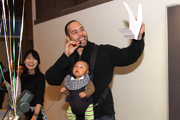March 18, 2010

Match Day 2010. Download image.
BIRMINGHAM, Ala. - The 162 members of the 2010 graduating class of the University of Alabama at Birmingham (UAB) School of Medicine exceeded the national average for matching to one of their top choices for residency training in the most competitive Match Day ever.
Match Day is when graduating seniors at U.S. medical schools learn where they will conduct their residency training and in which field. Match Day, coordinated by the National Resident Matching Program, involves approximately 16,000 U.S. medical school seniors and another 15,000 graduates of osteopathic or foreign medical schools.
The 2010 class is the first graduating class since the Association of American Medical Schools and the federal government pushed for U.S. medical schools to increase enrollment to meet an expected future need for more doctors. UAB, along with other schools, met that challenge and increased enrollment by 10 percent in 2006. The number of available residency positions, however, has grown more slowly, increasing the competition for each available position.
"Ninety eight percent of our graduates matched to a program of their choice on the first round of the match, higher than the national average of 95 percent, and all had been successfully matched by the end of the proceedings," said UAB's Laura Kezar, M.D., associate dean for students. "And we're very pleased that 52 percent of our graduates matched in one of the primary care fields, our highest percentage in years."
Kezar said that boosting the number of primary-care physicians within the state of Alabama is one of the school's foremost missions. Forty percent of graduates in all specialties will remain in the state for residency training, and 76 percent will conduct their training somewhere in the Southeast.
"Studies have shown that physicians tend to establish their practices in the region or state where they conduct their residency training," said Kezar.
Overall, UAB's graduates will do residencies at 69 hospitals in 29 states. Eighteen percent will go into a surgical field, 7 percent into obstetrics-gynecology, 6 percent into anesthesiology and 5 percent into radiology.
Following graduation from medical school, new physicians spend at least three years in a residency program, receiving advanced training in their chosen field. Fourth-year medical school students across the country apply to their desired residency programs through the National Resident Matching Program and receive their acceptances on Match Day, begun in 1952.
About the UAB School of Medicine
Located at the University of Alabama at Birmingham, one of the South's premier research universities, the School of Medicine is dedicated to the education of physicians and scientists in all of the disciplines of medicine and biomedical investigation.